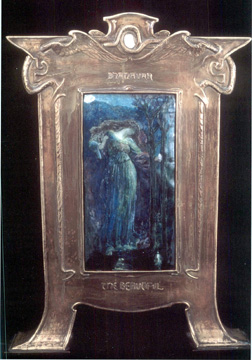
Alexander Fisher
British, 1864-1936
Bhanavar the Beautiful, 1903
enamel, limoge, cloisonne
24 1/2 x 19 1/8 x 4 1/4 in.
SBMA, Gift of the Women's Board
RESEARCH PAPER
This very lovely piece was given to the Museum by the Women's Board of the Museum in celebration of their 50th anniversary this year. It was created in 1903 by Alexander Fisher. Mr. Fisher was considered to be the master enamellist of his time and comparable to the goldsmith of the renaissance, Cellini. He was born in Great Britain 1864 and died in 1936. He taught at the LCC Central School of Arts and Crafts in 1896-1898 and later at other London schools. In the spirit of the Arts and Crafts Movement he felt that every piece of art should express an individual idea and should be designed and executed by the artist from beginning to end. Although his work is done in the spirit of the Arts and Crafts Movement, he was clearly influenced by the Art Noveau style which was referred to as Modern Style in Great Britain. The movement‚'s trademark was a fondness for geometric and floral lines; the referral to nature as indicated by the snake and the wings was more French than English.
Fisher was familiar with every aspect of enamelling; Limoge painting, cloisonné, champleve, basse taile and plique-a-jour. He made specimen pieces of each discipline, all demonstrating his skill. Plique-a-jour is extremely time consuming and subject to a high rate of failure. The object created is like a miniature stained glass. Champleve is enamelling done on an engraved surface. Basse Taille is similar to cloisonné. Cloisonné is probably the most familiar to us. It was developed in China. As you can see from this small example, brass wire is soldered to a brass or copper surface to form the pattern. The formed spaces are then filled with enamel. The enamel is made of various materials such as red lead for color and combined with glass powder. The enamels can be either opaque or translucent and are generally applied in a wet pack using a liquid base such as gum arabic to make the enamel adhere to the metal before firing . After thoroughly drying the piece is fired. As the enamel shrinks the process is repeated until the surface is smooth. After all the enamel is applied the piece is polished, and the exposed brass
surfaces are gold plated.
The last process is Limoge painting which is how this piece was most likely created. The name comes from the French town famous also for superior china ware. The enamel is applied by brush using the wet pack and applied in layers so that it can be fired at the melting point of the material used for each color. The piece is also counter enameled; the back is enameled to balance the front. This piece was made using this method. Unfortunately, it is very easy to see that it is glass as the light captures the fractures in the glass. This is quite easily repaired by refiring the piece.
In 1906, Fisher wrote and I quote, "enamels should never be copies of anything in nature nor of any other process in art. They should be creations. They are for the representation and embodiment of thoughts, ideas, imaginings, and for most parts of a world that exists only on minds." Which brings us to the imaginings presented here with Bhanavar the Beautiful. The image is taken from a short story, "The Shaving of Shagpat," by George Meredith. The story tells of a beautiful daughter of an emir whose tribe lived on a lake in the Caucasus. She was engaged to the son of an emir of a neighboring tribe. One reflection of a large star in the lake. It was not a star but a wise, old and powerful serpent who wore an incredible jewel in her forehead, Zurvan advised Bhanavar not to look upon the snake. But the wish to possess this jewel was great and she wished for it despite the warning that the jewel would bring misfortune to anyone who possessed it. Zurvan told her to meet him again at the quarter moon. He had the Jewel! But in the process of obtaining it he was bitten and died of his wound, Meredith goes on to tell the travails of Bhanavar because of the jewel. We can see the jewel gleaming in her hand and reflected in the water. This is certainly an imaginary piece, quite lovely and romantic. You can see the representation of the jewel in the blister pearl at the top of the overmantel and, of course, the snakes that wind around it refer back to the story. Blister pearls are a phenomena of an oyster; they are attached to the inside of the shell. The nacre or shine extends to the shell. The shells are cut to include the blister in a number of shapes, if we could see the back of this pearl we would probably see the dark brown surface of the shell.
Bhanavar the Beautiful, Provisional Research paper by Sonya Johnson
